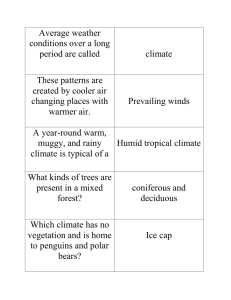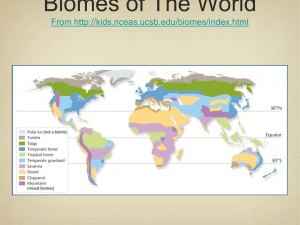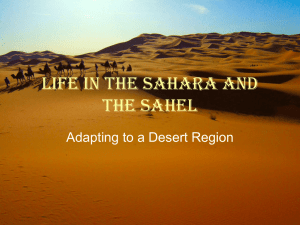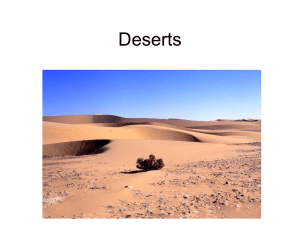Home sequence five II. Watch the film and find the missing words
advertisement
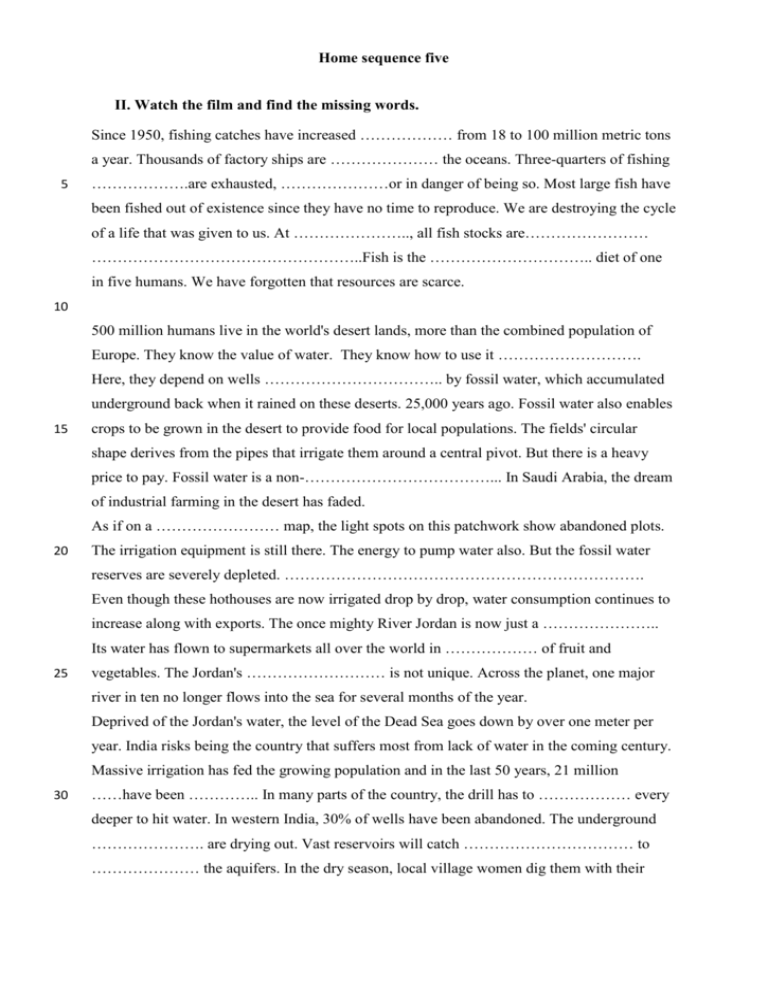
Home sequence five II. Watch the film and find the missing words. Since 1950, fishing catches have increased ……………… from 18 to 100 million metric tons a year. Thousands of factory ships are ………………… the oceans. Three-quarters of fishing 5 ……………….are exhausted, …………………or in danger of being so. Most large fish have been fished out of existence since they have no time to reproduce. We are destroying the cycle of a life that was given to us. At ………………….., all fish stocks are…………………… ……………………………………………..Fish is the ………………………….. diet of one in five humans. We have forgotten that resources are scarce. 10 500 million humans live in the world's desert lands, more than the combined population of Europe. They know the value of water. They know how to use it ………………………. Here, they depend on wells …………………………….. by fossil water, which accumulated underground back when it rained on these deserts. 25,000 years ago. Fossil water also enables 15 crops to be grown in the desert to provide food for local populations. The fields' circular shape derives from the pipes that irrigate them around a central pivot. But there is a heavy price to pay. Fossil water is a non-………………………………... In Saudi Arabia, the dream of industrial farming in the desert has faded. As if on a …………………… map, the light spots on this patchwork show abandoned plots. 20 The irrigation equipment is still there. The energy to pump water also. But the fossil water reserves are severely depleted. ……………………………………………………………. Even though these hothouses are now irrigated drop by drop, water consumption continues to increase along with exports. The once mighty River Jordan is now just a ………………….. Its water has flown to supermarkets all over the world in ……………… of fruit and 25 vegetables. The Jordan's ……………………… is not unique. Across the planet, one major river in ten no longer flows into the sea for several months of the year. Deprived of the Jordan's water, the level of the Dead Sea goes down by over one meter per year. India risks being the country that suffers most from lack of water in the coming century. Massive irrigation has fed the growing population and in the last 50 years, 21 million 30 ……have been ………….. In many parts of the country, the drill has to ……………… every deeper to hit water. In western India, 30% of wells have been abandoned. The underground …………………. are drying out. Vast reservoirs will catch …………………………… to ………………… the aquifers. In the dry season, local village women dig them with their ………………. Thousands of kilometers away, 800 to 1,000 liters of water are consumed per 35 person per day. Las Vegas was built out of the desert. Millions of people live there. Thousands more arrive every month. Its inhabitants are among the biggest water consumers in the world. Palm Springs is another desert city with tropical vegetation and …………… golf courses. How long can this mirage continue to prosper? The Earth cannot keep up. The Colorado River, which brings water to these cities, is one of those rivers that no longer …… 40 the sea. Water levels in the ………………….. lakes along its course are ………………. Water shortages could affect nearly 2 billion people before 2025. The …………………. represent 6% of the surface of the planet. Under their calm waters lies a veritable factory, where plants and micro-organisms patiently filter the water and digest all the pollution. These ………………………. are indispensable environments for the 45 regeneration and purification of water. They are sponges that regulate the flow of water. They absorb it in the wet season and release it in the dry season. In our race to conquer more land, we have ………………..........them as pasture for livestock, or as land for agriculture or building. In the last century, half the world's marshes were ……………………... We know …………………………………………….. 50 All living matter is linked. Water, air, soil, trees. The world's magic is right in front of our eyes. Trees breathe groundwater into the atmosphere as light ……………. They form a ……………….. that ………………………… the impact of heavy rains. The forests provide the humidity that is necessary for life. They store carbon, containing more than all the Earth's atmosphere. They are the ………………………………of the climatic balance on which we 55 all depend. Home sequence four I. Understanding 1. What kind of problems has the fishing industry created since 1950? 2. Why are these problems so serious for humankind? 3. What is the concern with water in desert lands? 4. What did the Saudis do in the desert? 5. What consequences does mass irrigation have on rivers? 6. What is happening to the Dead Sea? Do you know another sea which has been affected by irrigation? 7. How can digging reservoirs replenish aquifers? 8. Why does the Colorado no longer reach the sea? 9. What are the properties of wetlands? 10. What have human beings done with wetlands over the centuries? 11. Why are trees important for the local climate in an area? 12. Why are trees the cornerstone of climatic balance? Correction 1. Since 1950, fishing catches have increased fivefold. Three-quarters of fishing grounds are exhausted, depleted or in danger of being so. Most large fish have been fished out of existence since they have no time to reproduce. 2. These problems are very serious for humankind because fish is the staple diet of one in five humans. 3. In the deserts, water which replenishes wells, is fossil water which dates from an age when it rained on these deserts. So it is non renewable water. 4. In Saudi Arabia industrial farming has been put in place in the desert irrigated by fossil water which is now running out. 5. Across the planet, one major river in ten no longer flows into the sea for several months of the year. 6. Deprived of the Jordan's water, the level of the Dead Sea goes down by over one meter per year. The Aral Sea is also affected. 7. Digging reservoirs replenish aquifers because the water they stock seeps into soils towards aquifers. 8. The Colorado no longer reaches the sea because too many pipelines take too much water to cities like Las Vegas or Palm Spring which are more and more populated cities built in desert. 9. Wetlands are indispensable environments for the regeneration and purification of water. They are sponges that regulate the flow of water. They absorb it in the wet season and release it in the dry season. 10. In our race to conquer more land, we have reclaimed them as pasture for livestock, or as land for agriculture or building. In the last century, half the world's marshes have been drained. 11. Trees are important for local climate of an area because they breathe and pump the groundwater into the atmosphere as a light mist. They also form a canopy that alleviates the impact of heavy rains. Trees also prevent erosion. 12. Trees are the cornerstone of climatic balance because they store carbon, containing more than all that is the Earth's atmosphere.
